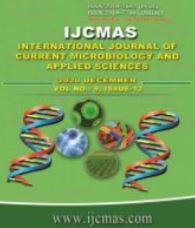


 National Academy of Agricultural Sciences (NAAS)
National Academy of Agricultural Sciences (NAAS)

|
PRINT ISSN : 2319-7692
Online ISSN : 2319-7706 Issues : 12 per year Publisher : Excellent Publishers Email : editorijcmas@gmail.com / submit@ijcmas.com Editor-in-chief: Dr.M.Prakash Index Copernicus ICV 2018: 95.39 NAAS RATING 2020: 5.38 |
High labour cost, scarcity of labour during the critical period of weed competition, and unfavorable weather at weeding time. Under such situation, herbicides have been tremendous contributor to agriculture. Direct seeding of rice (DSR) refers to the process of establishing the crop from seeds sown in the field rather than by transplanting seedling from the nursery. Before the advent of Green revolution and adoption of irrigation, rainfed rice was often broadcasted into moist soil and yields were low, variable and highly prone to weed competition. Weed spectrum and degree of infestation in rice field are often determined by rice ecosystems and establishment methods. The reduction in yield due to weed infestation under DSR is reported up to 50-80% and it can be reached to 100% if weeds are not controlled throughout the season. The main weeds of rice field such as Echinochloa spp., E. colona, Dactyloctenium aegyptium, Leptochloa chinensis and Elusine indica in DSR. Direct sowing rice matures 7 to 10 days earlier than transplanted rice due to absence of transplanting shock; which hastens physiological maturity and reduces vulnerability to late-season drought.Application of penoxsulam 25 g/ha as broad-spectrum, azimsulfuron + metsulfuron-methyl for Cyperus spp., pendimethalin at 1.25 kg/ha for Echinochloa spp. were found suitable for chemical weed management. All these herbicide mixtures were superior to weedy control in reducing the weeds’ density and dry weight.
 |
 |
 |
 |
 |